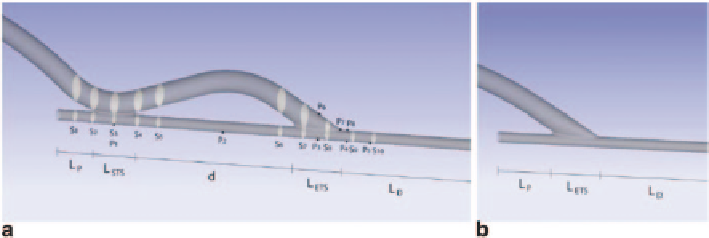Biomedical Engineering Reference
In-Depth Information
Fig. 8.60
Configuration of the coupled-sequential anastomosis (
SQA
) and conventional end-to-
side (
ETS
) models. Based on the coupled side-to-side:end-t-side sequential anastomoses model.
Sections, S
1
to S
10
and points, P
1
to P
7
indicate monitor the velocity profiles and WSS variations.
The conventional ETS anastomosis model is based on only a single connection to the main artery.
(Image from Kabinejadian and Ghista 2011)
8.7.1
Geometric Configurations and Computational Details
For the coronary artery, the coupled sequential anastomosis model and the con-
ventional end-to-side model are shown in Fig.
8.60
based on the following dimen-
sions: graft diameter,
D
G
= 4 mm, coronary artery diameter,
D
A
= 2 mm,
L
STS
= 9 mm,
d
= 20 mm,
L
ETS
= 10 mm for the sequential anastomosis model and
L
D
= 48 mm,
L
P
= 6.5 mm and 10 mm for the end-to-side model. Both models exhibit an end-to-
side anastomotic angle of 30°.
Patient-specific models of DeBakey III aortic dissection were reconstructed us-
ing commercial tool MIMICS (Materialise Europe, Leuven, Belgium). MRI serial
slices were integrated by medical image-processing techniques such as threshold
segmentation and region growing methods. The thickness of arterial wall was built
by offsetting the inner vessel wall 2 × 10
−3
m outwards according to the statistical
value of human aortic wall (Fig.
8.61
). Models with blind false lumen and through
false lumen were established separately. The model with blind false lumen was con-
structed artificially by cutting the false lumen for the sake of comparison between
different models (Fig.
8.61b
).
Two bypass graft strategies were applied to these dissection models: graft by-
passing between ascending aorta and abdominal aorta; and graft bypassing between
left subclavian artery and abdominal aorta. The four models of bypassed aortic dis-
section with different grafting procedures are shown in Fig.
8.62
. The aortic dissec-
tion models with the through and blind false lumens were also reserved to perform
numerical simulation for comparison with the bypassed models. Thus, totally there
are six models for the simulation.

Search WWH ::

Custom Search